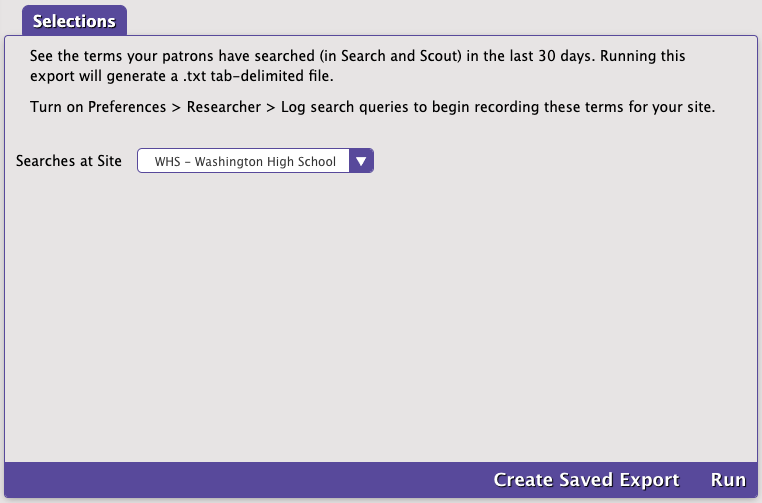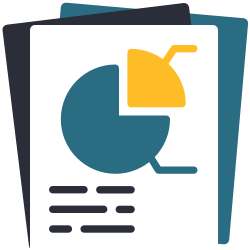Researcher Statistics

How are patrons using your library? Did your recent Magic Tree House activity increase interest in that series? Are more patrons checking Bulletins now? All of these questions and more can be answered by our statistics tools!
With the information you get from Alexandria’s Researcher statistics, you could:
- Plan activities around trending topics, books, or authors.
- Make sure you have items in your collection that fit current needs and interests.
- See if your actions to promote your library caused an increase in usage.
- Compare usage between various months (e.g. September vs. October).
Researcher Queries export
Use this export to see the terms your patrons have searched (in Search and Scout) in the last 30 days. Running this export will generate a .txt tab-delimited file, which can then be imported into a spreadsheet for analysis.

 | Alexandria only keeps this data for 30 days, so we recommend setting up a saved export that runs once a month. Then you’ll never have to worry about data expiring! |
Preference
In order for Alexandria to begin recording search terms, you need to turn on the Builder > Searching > Log search queries preference. Note that Alexandria will only record this data from the time you update to 20.12 and turn on this preference onward.
Text File
The .txt tab-delimited file can be imported into a spreadsheet program for easier analysis. So, what exactly does Alexandria record?
| DATE | INTERFACE | SITE CODE* | SEARCH TYPE + TERM(S) | ADDITIONAL | OVERFLOW | # OF RESULTS |
|---|---|---|---|---|---|---|
| 05/03/2021 | search | AMS | smart::cats | author::carle – genre::Fiction – site::KNOCOPY – sitersn::3 – hidetitle::0 | NONE | 23 |
| 05/07/2021 | search | AMS | author::riordan | pubyear::1999–2001 – medium::book – studyprogramnamecode::4 – studyreadinglevel::a–f, A–F | site::KNOCOPY – sitersn::2 – hidetitle::0 | 5 |
| 05/13/2021 | scout | JES | smart::”Percy*”, “Jackson*” | site::KNOCOPY – hidetitle::0 | NONE | 15 |
*If a patron searches by All Sites, the Union Site code will show.
Note that # of Results will be capped by what you have set in your Initial Search Results Returned preference.
Additional Column
The Additional column includes study program, medium, genres, and additional search types and terms (from Advanced Search) if they were used. There are a few other indicators you may notice:
- site::KNOCOPY. This means electronic items that have no copies were included. In other words, items that belong to the entire catalog rather than a specific site.
- sitersn::3. The sitersn is the location of a site within the database.
- hidetitle::0. This indicates whether the patron searched for hidden items. A 0 means no, and a 1 means yes.
- studyprogramnamecode::1. This tells you which study program was selected. Each study program is assigned a number:
- 1 = Accelerated Reader
- 2 = Reading Counts
- 3 = Fountas and Pinnell
- 4 = Guided Reading
- 5 = Lexile
If there’s a lot of information in the Additional column, it spills over into the Overflow column.
Analysis
Here are some things you can do in your spreadsheet to get useful information:
- Sort by the term to see similar terms. Then you can get an idea of what’s trending.
- Use spreadsheet features like “count” functions to make graphs for similar terms, or terms on a specific topic you’ve been promoting.
- Split columns to separate the search type with the terms.
- Sort by result # and see what’s happening that results in 0 items found. Maybe you need to add some more subjects and misspellings to the record, or add more books to your collection!
x
Researcher Monthly Usage report
This report will show you statistics on Researcher accessions and queries over time.
 | The earliest date for this data is April 2021 or site creation, whichever is most recent. |
Uses
- If you take measures to promote your library, see if those actions caused an increase in usage.
- Watch the numbers for monthly Researcher access and catalog searching for another view on how your students are using the library. (Pair with actual circulation usage, e.g. Top Circulated Items, Usage by Patron Policy, etc.)
Selections
Choose the date range for your statistics.

Example report



